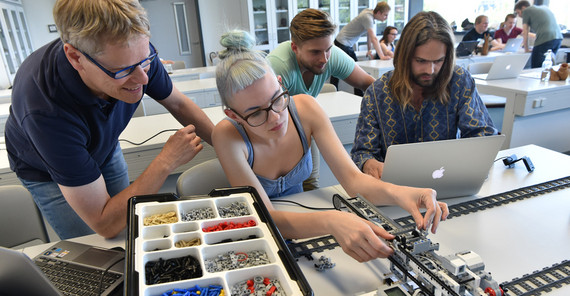A practical course with Martin Trauth is packed with high-tech: infrared and ultrasound sensors, gyroscopes, magnetometers, multispectral cameras – and Legos. Together with his students, Trauth uses Legos to develop, build and program geoscientific measuring systems on the scale of a laboratory table that are actually used in the field. His success is self-evident: the course is full and everything is enthusiastic, and so is Martin Trauth – about the possibilities and especially about the students.
It all began in a course about analyzing data in the geosciences, which Trauth, who is Professor for Paleoclimate Dynamics, teaches every year. “I thought that instead of giving everyone data that was measured in advance, it would be better to let them measure it themselves. And that it would be best to do it on the table in the seminar room,” says Trauth. The problem is that the measurement instruments required to do this are – in their original format – expensive and too unwieldy for a practical course. Things are different with Legos, which are by no means restricted to children’s playrooms. Lego, a giant company in Denmark, developed an entire product range called Mindstorm that uses pneumatic parts, gears, electrical motors, sensors, and even a programmable core element called the Lego Mindstorms EV3 Brick, and this system has also been used in teaching for some time now. Trauth had worked in the early 1990s with the MATLAB programming language, which is broadly used in the geosciences, and he had even written one of the most successful textbooks about it. When he found out that there is an interface between MATLAB and Lego Mindstorms, the next step was easy.
Thanks to MathWorks, the company behind MATLAB that supported Trauth’s idea, there were soon € 6,000 worth of Lego blocks and sensors on his desk – and then in front of the students. Since then, there is a lot of building, programming and measuring in the data analysis course. “The students really enjoy the practical course,” says Trauth with pride, “because every time people try out something zany.” For starters, students had to build a car that drives straight ahead, stops 30 cm before an obstacle, honks, and drives back. They have to come up with their own ideas on how to do it. Trauth and his team can step in and help if necessary. “The students do what we are constantly doing in the sciences: apply what we learn to develop something new. And if something goes wrong, then start over.”
Simple tasks are followed by more complicated ones: using an ultrasound sensor to measure three-dimensional objects, for example. “The great thing is that the more complicated the exercises, the less help they need,” says Trauth. The 90-minute course sessions sometimes last up to three hours, but nobody wants to leave. “The students are working and enjoying it, above all because of the Legos. Everyone knows and loves Legos. Their instinct for play is awakened, and there’s a lot of laughter during the course.”
Trauth himself is currently in the grip of Lego fever, now that he’s building Lego cars – again – with his four-year-old son. Yet he never forgets the objective of the practical course: “I helped people get started with programming by appealing to their playful side. They build their instructions themselves and learn how to solve problems and find errors.” And Trauth’s idea is working; the course is growing. More and more of his departmental colleagues want to jump onboard. One student uses a magnet sensor to trace a model of a Roman villa; another is planning how to measure the tiniest tremors with seismographs. Even a Raman spectroscope will soon find its way into the course. The practical course has become a mandatory module in the new master's degree program in Remote Sensing, geoInformation and Visualization.
It almost seems as if the creators of Lego, way back in 1975, had already caught a glimpse of Trauth’s Lego course when they developed a slogan that he could use to greet his students today: “You can do more with Legos.”
Here’s a link to Martin Trauth’s blog on his Lego course, with numerous examples and video: http://mres.uni-potsdam.de/index.php/category/Lego/
Text: Matthias Zimmermann
Translation: Dr. Lee Holt
Published online by: Marieke Bäumer
Contact for the online editorial office: onlineredaktionuuni-potsdampde

